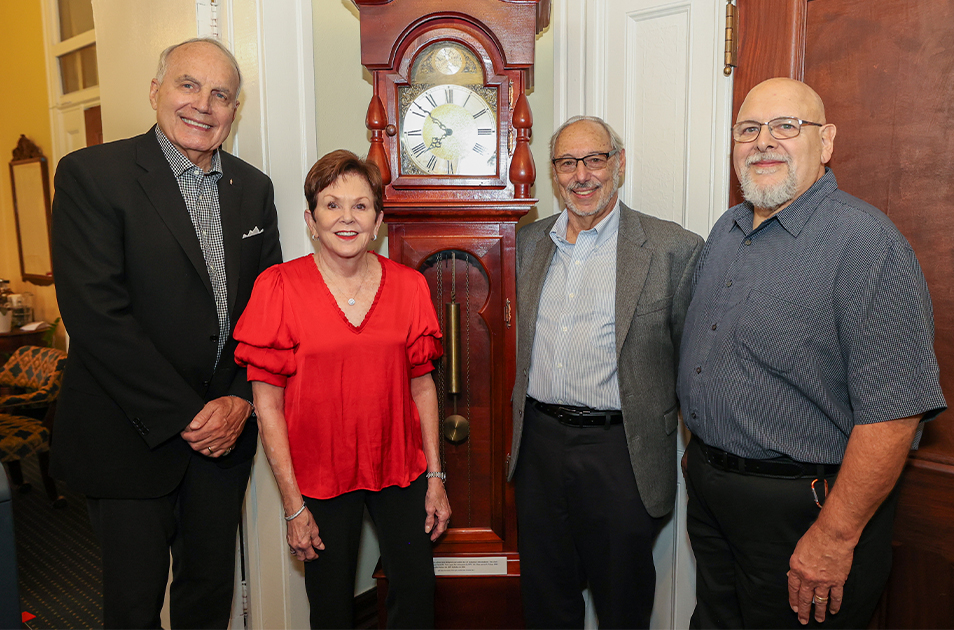Campus Clock is a Relic of What Made Them Tick
SPARTAN SPOTLIGHT: Peter Nuccio ’73 and Augie Martinez ’73
 From left: President Vaughn, Renée Vaughn, Peter Nuccio ’73, Augie Martinez ’73. Photo by Jessica Leigh
From left: President Vaughn, Renée Vaughn, Peter Nuccio ’73, Augie Martinez ’73. Photo by Jessica Leigh
By Lena Malpeli ’25
A grandfather clock towers over anyone who steps into a staff office on the first floor of Plant Hall.
The clock’s wood casing, adorned with minarets above and beside the clock face, looks like a Greek column colored burnt umber and russet brown, darkened with age at its corners.
Above the face of the clock is a silver engraving of a globe with the words “Tempus Fugit”— time flies.
Time has flown, and nostalgia runs deep for Peter Nuccio and Augie Martinez, both industrial arts majors from the class of ’73, who helped build the clock during their time at UT.
They built it in “the Barn,” which, according to the Macdonald-Kelce Library archives, was a concrete block building with a shingled roof, where Professor James Bignell Sr. one day asked for help on a special project — a retirement gift for his close friend, President David Delo.
“It was an extra thing that we did,” Nuccio explained. “It wasn’t any part of the curriculum. It wasn’t any part of a senior project. We did it on our own time.”
UT’s industrial arts program wasn’t just a wood-shop class. Students could take anything from metalworking to descriptive geometry. The environment in the Barn was relaxed, Martinez said, and students could drop by at 8 a.m. on a Saturday to work on their projects. Then the Barn would be open well into the night.
It was a special place and a special time, the men remember.
“We weren’t afraid to help one another if somebody was having a little difficulty with something. There was always somebody there, two, three people, to help finish stuff up,” Nuccio said.
Martinez even met his wife, Marilyn (Anderson) Martinez ’73, in a crafts class held in the Barn.
The clock project was a joint effort by many students, Nuccio said. Bignell designed the plans and ordered the inner parts from Mason and Sullivan, one of the premier clockwork-makers in the United States. Martinez sanded and put together the casing while Nuccio lathed — and re-lathed, upon Bignell’s request — the minarets.
After Delo died, his widow donated the clock back to the University.
“It represented the University. And also, it was a remembrance, a carrying on of Dr. Delo’s tenure there, and a carrying on of the industrial arts program,” Nuccio said.
UT’s industrial arts program closed in the late ’70s, and beyond the clock, Martinez and Nuccio did their part to carry on its legacy: Both men had decades-long careers teaching industrial arts in public schools. Now, in retirement, they have time to reflect on their beginnings in the Barn and at UT.
“I credit UT for changing my life,” Nuccio said. As for the clock, he said, “I have a sense of pride that I had a part in it, but it’s more so what it represents — a piece of me as part of UT.”
